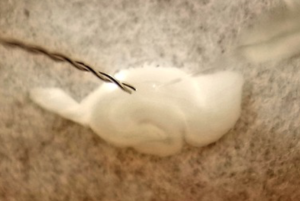 Neural network construction and information processing in the brain both require synaptic plasticity. As circuits in the mammalian forebrain mature, synaptic plasticity is adjusted to better suit information processing. Disruption of this process in the hippocampus has been implicated in various neurodevelopmental disorders, including schizophrenia and autism spectrum disorders. Moreover, hippocampal dysfunction in midlife is predictive of cognitive failure in aging. A key factor in normal maturation of the hippocampus is a shift in the composition of NMDA receptors at excitatory synapses (early postnatal = more GluN2B, late postnatal = more GluN2A incorporation). In the rodent hippocampus, this transition occurs around three postnatal weeks, culminating in the emergence of adult-like hippocampal-dependent learning and memory abilities. It was recently discovered that NMDA receptors produce signals via ion movement into the postsynaptic neuron (ionotropic) or without such ion conductance (nonionotropic). However, nobody knows how these two signaling streams act during hippocampal maturation. We record from acutely prepared hippocampal slices prepared from transgenic mice expressing chimeric Glun2 subunits and perform protein expression assays to address this question.
Neural network construction and information processing in the brain both require synaptic plasticity. As circuits in the mammalian forebrain mature, synaptic plasticity is adjusted to better suit information processing. Disruption of this process in the hippocampus has been implicated in various neurodevelopmental disorders, including schizophrenia and autism spectrum disorders. Moreover, hippocampal dysfunction in midlife is predictive of cognitive failure in aging. A key factor in normal maturation of the hippocampus is a shift in the composition of NMDA receptors at excitatory synapses (early postnatal = more GluN2B, late postnatal = more GluN2A incorporation). In the rodent hippocampus, this transition occurs around three postnatal weeks, culminating in the emergence of adult-like hippocampal-dependent learning and memory abilities. It was recently discovered that NMDA receptors produce signals via ion movement into the postsynaptic neuron (ionotropic) or without such ion conductance (nonionotropic). However, nobody knows how these two signaling streams act during hippocampal maturation. We record from acutely prepared hippocampal slices prepared from transgenic mice expressing chimeric Glun2 subunits and perform protein expression assays to address this question.
In aging, there is a lack of GluN2B incorporation into NMDA receptors, network dysfunction in area CA3 of the hippocampus, and a spatial memory impairment. Is this all due to a loss of ionotropic or nonionotropic signaling? We have been funded by the Commonwealth of Virginia (Virginia Commonwealth University, Alzheimer’s and Related Disorders Research Award Fund) to tackle this question. We implant recording electrodes into the hippocampus of transgenic mice expressing chimeric GluN2 subunits, to separate effects of ionotropic and nonionotropic signaling, and test these animals on the Barnes maze (a traditional test of spatial learning and memory). This research will pinpoint the molecular and synaptic determinants of network dysfunction and impaired spatial memory in Alzheimer’s disease.
